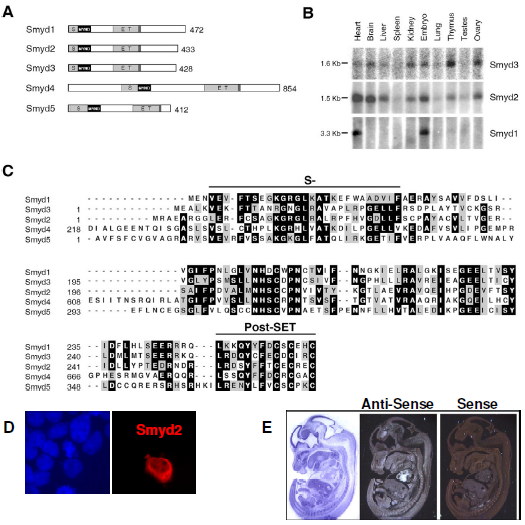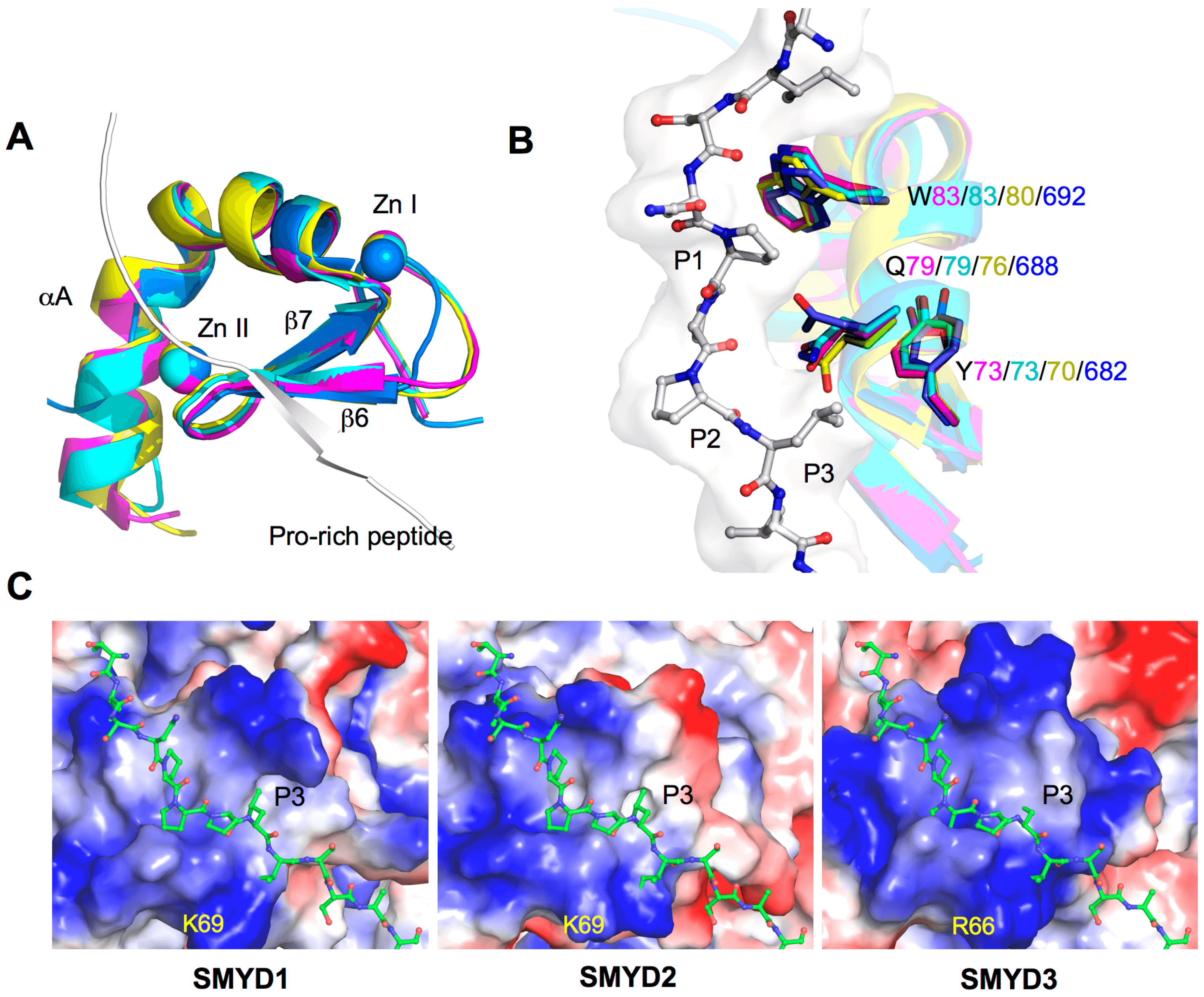In vitro diagnostic (IVD) antibodies play an essential role in disease diagnosis and therapeutic monitoring. Creative Biolabs is professional in the filed of IVD antibody development and antibody pair development. We have experienced experts and advanced platforms that enable us to provide unparalleled services targeting a panel of biomarkers. Here, we introduced the potential of SMYD2 as a diagnostic marker for renal cancer.
Introduction of SMYD2
In the human genome, there are over 50 SET domain-containing proteins encoded, but only a fraction have been shown to methylate histones. Of all the SET proteins, five clusters into a subfamily that contains a SET domain that is split into two segments by an MYND domain/zinc-finger motif, previously participated in protein-protein interactions.
SMYD2 (SET and MYND domain containing 2, also known as KMT3C, HSKM-B or ZMYND14), is a SET domain-containing protein with lysine methyltransferase capability. This protein with 433 amino acids catalyzes lysine methylation, which has SET domain, MYND domain/zinc-finger motif, as well as cysteine-rich post-SET domain. SMYD2 mRNA transcripts are wide and highly expressed in the tissues of heart, brain, kidney, liver, thymus, and ovary. Besides, both SMYD2 and SMYD3 transcripts are detectable in fetal mRNA, which suggests that as with other SMYD family proteins such as Smyd1 and SMYD3 might be implicated in the biological development.
 Fig.1 Alignment of the mammalian Smyd family proteins, and Smyd2 localization. (Brown, M.A., 2006)
Fig.1 Alignment of the mammalian Smyd family proteins, and Smyd2 localization. (Brown, M.A., 2006)
The function of SMYD2 is associated with the upregulation of 37 genes and down-regulation of 4 genes, the majority of which are involved in the chromatin remodeling, transcriptional regulation, and cell cycle. Among its correlated pathways are chromatin organization and p53 pathway. Similarly to histones, p53 is subject to activating and repressing lysine methylation. Initial evidence predicts that SMYD2 may perform a putative oncogene by methylating p53 and repress its tumor suppressive activity. There are other studies revealed that the SET domain of mammalian SMYD2 mediated demethylation of Lys-36 of histone H3, and SMYD2 repressed transcription from a reporter plasmid SV40. And in mouse fibroblasts, exogenous levels of SMYD2 decrease cell growth.
 Fig.2 Structure of MYND domains. (Spellmon, N., 2015)
Fig.2 Structure of MYND domains. (Spellmon, N., 2015)
Related Diseases with SMYD2
- Esophageal squamous cell carcinoma (ESCC)
SMYD2 mRNA and protein are frequently over-expressed in KYSE150 cells and other ESCC cell lines. High level of SMYD2 protein is often observed in primary tumor samples of ESCC as well and significantly related to gender, venous invasion, the pT category and status of recurrence. Patients with SMYD2-overexpressing neoplasms have a worse overall rate of survival than those with non-expressing neoplasms.
- Thyroid carcinoma and benign thyroid nodule (BTN)
By the method of differential display-polymerase chain reaction (PCR), the gene expression differences between BTN (15 patients) together with follicular (14 patients) and classic variants (13 patients) of papillary thyroid carcinoma (PTC) are assessed in 42 patients. SMYD2 shows a lower level in both carcinoma groups than in BTN ones.
- Breast cancer
SMYD2 is expressed at significantly higher levels in breast cancer cells and tumor tissues. It is reported that the expression of three genes, SMYD2, MTSS1, and RPL37, is evaluated by real-time PCR exhibiting a potential candidate to predict response to neoadjuvant chemotherapy in patients with breast cancer.
SMYD2 and RCC
Lysine methyltransferases catalyze the transfer of methyl groups from S-adenosylmethionine to the lysine residues of histones, especially histones H3 and H4. This dysregulation of methylation is crucial in the development of most cancers. Confirmation of SMYD2, SETD3, and NO66 by real-time PCR in a series of 160 renal cell carcinomas (RCC) and 10 renal normal tissues (RNT) validates that the three enzymes are significantly overexpressed in RCC when compared to RNT. Among analysis of four RCC subtypes, chromophobe RCC (chRCC) reveals the highest expressions for the three genes, followed by oncocytoma (a benign tumor) and then by papillary RCC (pRCC) and clear cell RCC (ccRCC). Pairwise comparisons demonstrate statistically significant differences of SMYD2, SETD3, and NO66 level, between chRCC and pRCC, chRCC and ccRCC. Furthermore, SMYD2 expressions differ significantly among chRCC and oncocytoma.
IVD Antibody Development Service for SMYD2 Marker
With extensive experience and advanced technologies, Creative Biolabs has been recognized as an expert in the field of IVD antibody development. Our scientific team is able to provide polyclonal, monoclonal, and recombinant antibody development services for diagnostic use. Besides, we help develop high-quality IVD immunoassays of different formats, giving expert support in feasibility analysis, protocol establishment, assay design, validation, and kit production. Our services are customized to suit the specific requirements of our clients.
Please contact us for more details if you are interested in our service.
References
- Brown, M.A., (2006). “Identification and characterization of Smyd2: a split SET/MYND domain-containing histone H3 lysine 36-specific methyltransferase that interacts with the Sin3 histone deacetylase complex.” Mol Cancer, 5, 26. Distributed under Open Access license CC BY 2.0, without modification.
- Spellmon, N., (2015). “Structure and function of SET and MYND domain-containing proteins.” International journal of molecular sciences, 16(1), 1406-1428. Distributed under Open Access license CC BY 4.0, without modification.
For Research Use Only.

